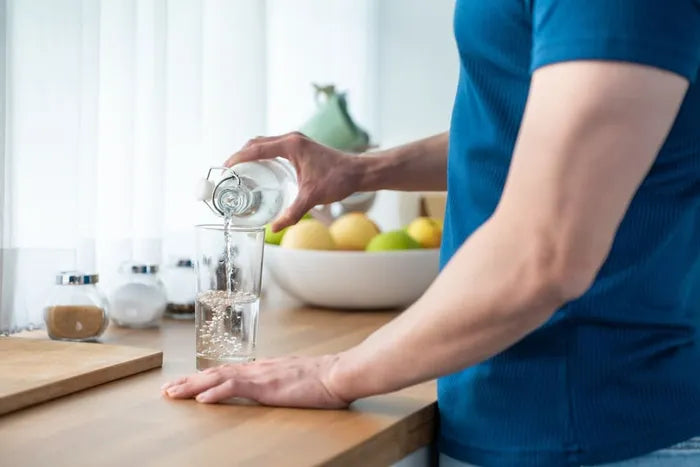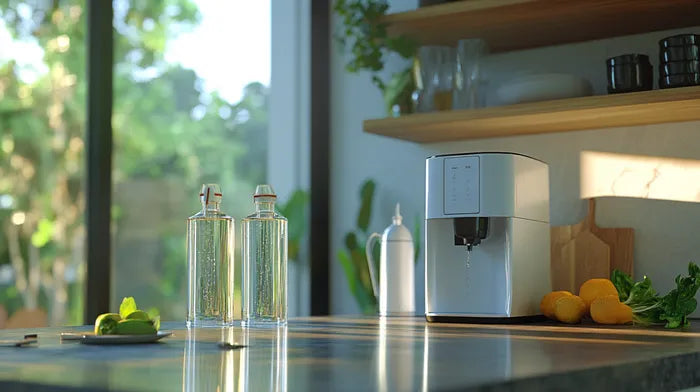Glass vs. Plastic Bottles: The Sustainable Option
Published October 6, 2024

Plastic tends to get a bad rep from environmentalists, especially because only 9 percent of all plastic is recycled. However, there's a lot more to consider regarding the manufacturing and recycling processes of both glass and plastic, and their impact on the environment. There's some debate about which is truly a more sustainable option. We've outlined everything you need to know in this article.
Is Glass Really Environmentally Friendly?
There are a few reasons why glass is viewed as more sustainable water bottle material than plastic. Glass is much more durable than plastic and can last many years when handled properly. Glass can also be cleaned and sterilized easily. Glass is endlessly recyclable (back to its original use) and never loses its purity or quality.
However, just like with anything manufactured in the world, there will be an environmental impact. Here are three of the concerns around the environmental impact of glass:
Resources
Manufacturing new glass requires sand, and while we have tons of sand in deserts and on beaches, that's not the sand required for glass production. We use more sand than oil, and we're using it faster than it can be replenished. The sand needed for glass is harvested from seabeds and riverbeds. Removing this sand from the natural environment disrupts the ecosystem and causes flooding and erosion.
Production
The furnaces used to create the glass utilize fossil fuels, which create a lot of pollution. Glass also weighs more than plastic and is more prone to breaking during transit. This means the transportation involved with shipping glass produces higher emissions and costs more.
Recycling
Less than 35 percent of glass waste is recycled worldwide. While glass is completely recyclable, certain facilities choose to crush the glass and use it as landfill cover instead.
Sustainability of Glass Bottles vs. Plastic Bottles
A glass water bottle is still considered more eco-friendly and safer than a plastic bottle. Plastic is everywhere: it’s lightweight, waterproof, and doesn't break when it’s dropped. However, there are a lot of negative implications involved in its production:
Resources
Plastic is petroleum-based which is a non-renewable resource. Plastic is made from petroleum gas, natural gas liquids, and natural gases, accessed by drilling deep into the earth’s crust. Its production pollutes the air with greenhouse gas emissions, and the extraction process of natural resources often leads to contamination of waterways, rivers, and topsoil.
Pollution
Plastic bottles also end up in landfills, oceans, and waterways. Not all plastic is recyclable, and plastic never truly breaks down. It turns into microplastics that have been found in oceans, rivers, rain, and drinking water. Plastic bottles leach harmful chemicals into the earth. A single plastic bottle can leach up to 8700 different substances into the water and soil.
Bisphenol A (BPA)
People try to reduce plastic waste by reusing plastic bottles. However, this is unadvisable because plastic bottles also leach chemicals into the liquid they're holding. A study from the Harvard School of Public Health showed that people who drank from plastic water bottles for one week had an increase of two-thirds of the BPA chemical in their urine. BPA has been shown to have negative effects on human health.
Comparison to Glass Bottles
On the other hand, glass is made from sand, limestone, ash, and other recycled glass. Most of these resources are widely available, with a minimal impact on the earth. Glass bottles have higher durability and last much longer than plastic bottles. The lifespan of a glass bottle is years, while a plastic bottle is more often than not single-use.
While both glass and plastic impact the environment, a glass bottle is 100 percent recyclable, and fewer emissions are released into the air through its recycling and production processes. The glass recycling process is fairly quick, and a new bottle is back on the shelf in about 30 days.
Conclusion
The use of natural resources and manufacturing will always result in an unwanted impact on the environment. However, a lot less glass is produced and discarded thanks to its reusable properties, making glass bottles a more sustainable option.












































